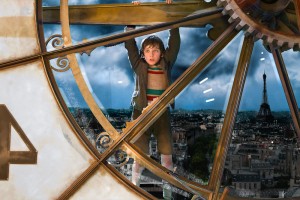 This Thanksgiving holiday, Martin Scorsese has given us one extra thing to count among our blessings: proof that 3-D is not on its last blurry, run-into-the-ground legs. Famous for bloody crimefests such as “Goodfellas,” “The Departed” and “Taxi Driver¸” the director has completely switched gears, transforming Brian Selznick’s novel, “The Invention of Hugo Cabret,” into a ticking, steam-powered marvel as captivating as the clockwork that fuels the tale.
This Thanksgiving holiday, Martin Scorsese has given us one extra thing to count among our blessings: proof that 3-D is not on its last blurry, run-into-the-ground legs. Famous for bloody crimefests such as “Goodfellas,” “The Departed” and “Taxi Driver¸” the director has completely switched gears, transforming Brian Selznick’s novel, “The Invention of Hugo Cabret,” into a ticking, steam-powered marvel as captivating as the clockwork that fuels the tale.
In the heart of a 1930s Paris train station, being on time is a way of life, which is helped along by the unseen hand of orphan Hugo Cabret, who lives inside the walls of the building. Played by Asa Butterfield, it’s impossible not to fall utterly in love with the little urchin, his ocean-colored eyes and grubby cherubic features melting your heart in moments. After the tragic death of his father, our young hero came under the care of his alcoholic uncle, who taught him how to tend to the station’s innumerable clocks. Eventually, Uncle Claude and his flask vanish as well, leaving Hugo to keep things running smoothly on his own.
Aside from his timekeeper duties, Hugo has a second passion: an intricate automaton, designed to write out a message through a pen clutched in its tarnished metal fingers, which his father discovered abandoned in the museum in which he worked. The father-son team was determined to bring it back to working order, but Mr. Cabret’s demise cut the work short. Now Hugo filches what cogs and gears he can to complete the repair work.
Unfortunately, this leads him to a run-in with the grouchy owner of the station’s toy stand, who catches him in the midst of lifting some of his merchandise. Ben Kingsley, one of the film’s biggest names, masters the gruffness and bushy eyebrows of the classic tired old man with the grandfatherly heart. In order to win back a notebook of automaton sketches that the toy man confiscates, Hugo becomes his part-time assistant at the booth.
This mishap also brings Hugo face to face with Isabelle, his new boss’s fast-witted bookworm goddaughter. With a history of playing pint-sized bruisers in films like “Kick-Ass” and “Let Me In,” seeing Chloe Grace Moretz sporting a jaunty beret and petit French-girl sweaters, popping off words like “clandestine” with glee, shows how much the actress has expanded her repertoire. By a coincidence only made possible on the silver screen, Hugo’s new companion just so happens to have the heart-shaped key required to bring the automaton to life.
Now the history lesson comes into play. It turns out that the automaton isn’t an author, but an artist, sketching out a picture of a space capsule embedded in the eye socket of a grimacing Man in the Moon, signed “Georges Melies.” Anyone knowledgeable in the way of classic cinema will recognize this as the iconic image of the real-life silent black-and-white production, “Le Voyage dans la Lune.” This drawing leads the duo on a quest to discover the story behind Melies. The truth is much closer to home than you’d think, but for the sake of spoiler alerts, I’ll let you figure that out yourself.
The advertising work done for “Hugo” makes it out to be a whimsical fantasy adventure with a bit of slapstick for good measure, highlighted by our boy precariously dangling from the face of an enormous clock. Actually, the majority of the movie is Hugo and Isabelle’s search for answers, punctuated by occasional spurts of action. There are emotional moments galore from nearly every character, coupled with some diminutive side plots, such as two potential lovebirds’ attempts at contact repeatedly being foiled by the lady’s ornery dachshund. Sacha Baron Cohen, playing an orphan-snagging station inspector who seems a fusion of “Chitty Chitty Bang Bang’s” Child-Catcher and “Young Frankenstein’s” Inspector Kemp, is aggravated by his malfunctioning leg brace interfering with his chances to woo a pretty flower seller.
Unlike mostly gimmick-ridden, poorly constructed 3-D creations bogging down theaters as of late, “Hugo” uses its extra dimension beautifully, giving the sweeping Paris cityscape and glittering clocks texture and warmth. If the film has one fault, it’s an excess of fabricated environments. At times it’s virtually impossible to tell whether any of the set is genuine or digitally inserted. However, it does give a sense of whimsy and fantasy to the snowswept land, embodying the sketches which make up the majority of Selznick’s beloved book. Amid a blood-saturated downer of a winter movie season, as cheesy as it may sound, “Hugo” is that “feel-good family film” we all secretly wish for.

